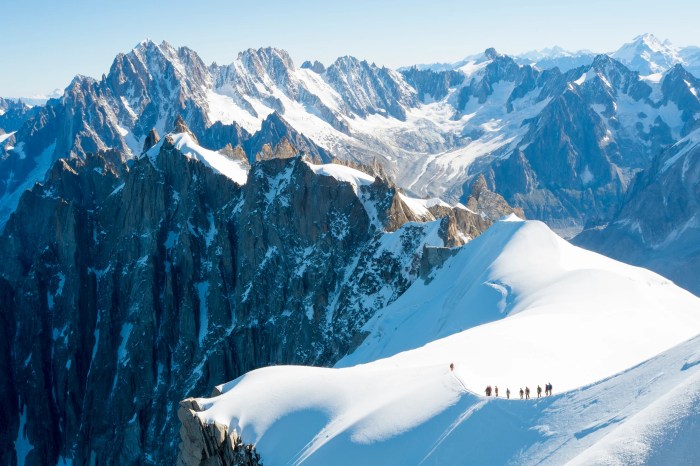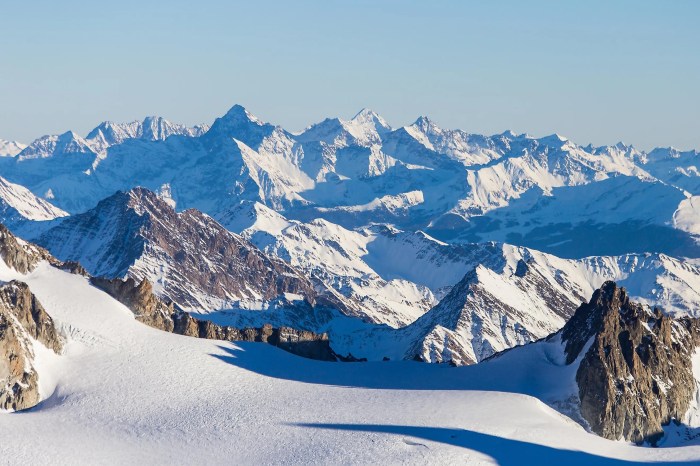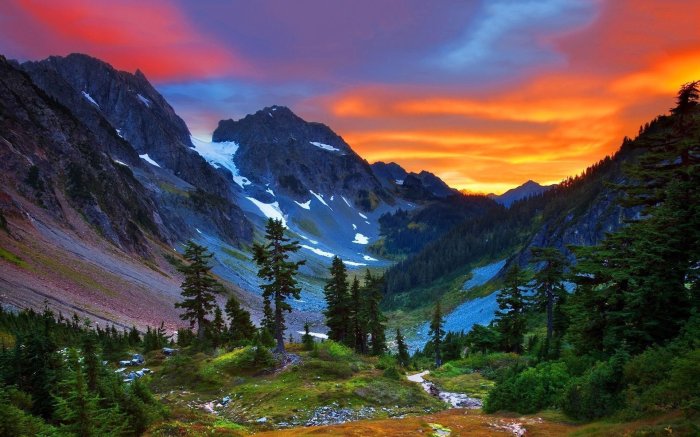The Alps, an awe-inspiring mountain range that stretches across Europe, captivate with their grandeur and allure. From towering peaks to verdant valleys, the Alps have shaped history, culture, and the natural world for centuries.
Delve into the geological forces that forged these mountains, explore the diverse ecosystems that thrive within their slopes, and discover the human stories that have unfolded amidst their breathtaking landscapes.
Geographic Location and Topography

The Alps are a majestic mountain range located in the heart of Europe. They stretch across eight countries: France, Italy, Switzerland, Austria, Germany, Slovenia, Liechtenstein, and Monaco. The Alps are divided into three main mountain ranges: the Western Alps, the Eastern Alps, and the Southern Alps.
The Alps, a majestic mountain range stretching across Europe, offer breathtaking scenery and world-class skiing. Whether you’re seeking adventure or relaxation, the Alps cater to all tastes. For the ultimate in luxury, consider exploring the top luxury travel destinations nestled within these towering peaks.
From exclusive resorts to Michelin-starred restaurants, the Alps offer an unforgettable experience that will leave you longing for more.
Unique Topography
The Alps are known for their stunning and diverse topography. The range is home to some of the highest peaks in Europe, including Mont Blanc, the Matterhorn, and the Jungfrau. The Alps also feature deep valleys, glaciers, and lakes. The unique topography of the Alps has been shaped by millions of years of geological activity.
Major Alpine Peaks
The following table compares the altitudes and prominence of the major Alpine peaks:
| Peak | Altitude (m) | Prominence (m) |
|---|---|---|
| Mont Blanc | 4,808 | 4,696 |
| Matterhorn | 4,478 | 1,042 |
| Jungfrau | 4,158 | 1,404 |
| Großglockner | 3,798 | 2,424 |
Geological Formation and History
The Alps, one of the world’s most iconic mountain ranges, were formed over millions of years through a complex series of geological processes. The collision of the African and Eurasian tectonic plates, which began about 30 million years ago, played a major role in their formation.
Collision of Tectonic Plates, Alps
As the African Plate moved northward, it collided with the Eurasian Plate, causing the Earth’s crust to buckle and fold. This collision led to the formation of the Alps, as well as other mountain ranges such as the Himalayas.
Rock Types
The Alps are composed of a variety of rock types, including sedimentary, metamorphic, and igneous rocks. Sedimentary rocks, such as limestone and sandstone, were formed from the accumulation of sediments over time. Metamorphic rocks, such as marble and schist, were formed when sedimentary rocks were subjected to heat and pressure. Igneous rocks, such as granite and basalt, were formed from the cooling and solidification of molten rock.
The Alps, a majestic mountain range stretching across Europe, offer breathtaking landscapes and world-class ski resorts. For those seeking the ultimate in luxury travel, the Alps feature some of the top luxury travel destinations in the world. From opulent hotels nestled amidst towering peaks to Michelin-starred restaurants serving delectable cuisine, the Alps cater to discerning travelers who appreciate the finer things in life.
The pristine beauty of the alpine environment, combined with the unparalleled amenities and experiences available, make the Alps an unforgettable destination for those seeking the ultimate in luxury travel.
Timeline of Geological Events
The geological history of the Alps can be divided into several major events:
- Collision of the African and Eurasian Plates (30 million years ago): This collision initiated the formation of the Alps.
- Uplift of the Alps (10-5 million years ago): As the plates continued to collide, the Alps were uplifted, reaching their current elevations.
- Glaciation (2 million years ago to 10,000 years ago): During several periods of glaciation, glaciers carved out the valleys and peaks of the Alps.
- Post-glacial Period (10,000 years ago to present): After the last ice age, the glaciers retreated, leaving behind the landscape we see today.
Climate and Weather Patterns: Alps
The Alps exhibit a diverse range of climate zones due to variations in altitude and topography. These zones include:
- Continental climate: Found in the northern and eastern Alps, characterized by cold winters and warm summers with moderate rainfall.
- Alpine climate: Prevalent at higher elevations, featuring short, cool summers and long, snowy winters with heavy snowfall.
- Mediterranean climate: Found in the southern Alps, characterized by mild, wet winters and hot, dry summers.
Altitude and Topography
Altitude significantly influences weather patterns in the Alps. As elevation increases, temperatures decrease, and precipitation increases. Topography also plays a role, with mountain ranges blocking moisture-carrying winds and creating rain shadows on the leeward side.
Climate Change
Climate change is impacting the Alps, leading to:
- Increased temperatures, resulting in melting glaciers and reduced snow cover.
- Changes in precipitation patterns, with more intense and frequent storms.
- Shifts in plant and animal life, as species adapt to changing conditions.
Flora and Fauna
The Alps are home to a wide variety of plant and animal species, adapted to the harsh mountain environment. These species include a range of endemic species, found nowhere else in the world.
Alpine flora is characterized by its low stature and thick, waxy leaves, which help to protect it from the cold and wind. Alpine plants also tend to have a high root-to-shoot ratio, which helps to anchor them in the thin soil and prevents them from being blown away. Some of the most common Alpine plants include edelweiss, gentians, and alpine roses.
Alpine fauna is also well-adapted to the mountain environment. Many animals have thick fur or feathers to keep them warm, and some have specialized adaptations for climbing or living in the snow. Some of the most common Alpine animals include ibex, chamois, marmots, and eagles.
Conservation Status
Many Alpine species are threatened by habitat loss, climate change, and other human activities. The following table shows the distribution and conservation status of some of the most threatened Alpine species:
| Species | Distribution | Conservation Status | Threats |
|---|---|---|---|
| Ibex | Alps | Vulnerable | Habitat loss, hunting |
| Chamois | Alps | Near Threatened | Habitat loss, hunting |
| Marmot | Alps | Least Concern | Habitat loss, climate change |
| Alpine eagle | Alps | Endangered | Habitat loss, hunting, poisoning |
Human History and Culture
The Alps have been home to human settlement for thousands of years, with evidence of human activity dating back to the Paleolithic era. The region has been a crossroads for trade and migration, and has seen the rise and fall of many different cultures.
Prehistoric Settlement
The earliest known inhabitants of the Alps were nomadic hunter-gatherers who lived in the region during the Ice Age. As the glaciers retreated, people began to settle in the valleys and foothills of the Alps, and agriculture began to develop.
The Celts
The Celts were one of the first major groups to settle in the Alps. They arrived in the region around 500 BC, and established a number of settlements and fortresses. The Celts were skilled metalworkers and farmers, and they played an important role in the development of Alpine culture.
The Romans
The Romans conquered the Alps in the 1st century BC, and the region became part of the Roman Empire. The Romans built roads, bridges, and aqueducts in the Alps, and they also introduced Christianity to the region.
The Middle Ages
The Middle Ages was a time of great change in the Alps. The region was divided into a number of small kingdoms and duchies, and there was a great deal of warfare and conflict. The Alps were also a major center of religious pilgrimage, and many monasteries and churches were built in the region.
The Modern Era
The modern era began in the Alps in the 18th century, with the rise of tourism and the development of mountain climbing. The Alps have become a popular destination for skiers, hikers, and climbers, and the region is now home to a number of major tourist resorts.
Cultural Traditions and Languages
The Alps are home to a diverse range of cultural traditions and languages. The region is divided into a number of different linguistic areas, including French, Italian, German, and Romansh. Each of these areas has its own unique culture and traditions.
Major Cities and Towns
The Alps are home to a number of major cities and towns, including:
- Geneva, Switzerland
- Zurich, Switzerland
- Munich, Germany
- Innsbruck, Austria
- Bolzano, Italy
Economic Importance

The Alps, a majestic mountain range spanning several countries in Europe, holds immense economic significance. Its towering peaks, pristine lakes, and picturesque landscapes have made it a prime destination for tourism, while its abundant natural resources and strategic location have fostered agriculture, energy production, and other industries.
Tourism is a major economic driver in the Alps, with millions of visitors flocking to the region each year. The stunning scenery, world-class ski resorts, and charming villages attract tourists from around the globe, providing a significant source of income for local communities.
The Alps, a majestic mountain range spanning several countries, offer unparalleled opportunities for outdoor enthusiasts. If you seek a change of pace, consider exploring the sunny shores of Alicante, Spain. Alicante boasts pristine beaches, crystal-clear waters, and an array of climbing spots, providing a refreshing contrast to the rugged landscapes of the Alps.
However, the allure of the Alps remains strong, beckoning adventurers back to its towering peaks and breathtaking panoramas.
Agriculture
Agriculture has long been a vital part of the Alpine economy. The region’s fertile valleys and alpine pastures provide ideal conditions for grazing livestock, particularly cattle and sheep. Dairy farming is particularly prevalent, with the Alps being renowned for its production of high-quality cheeses and other dairy products.
Energy Production
The Alps are also an important source of energy, particularly hydroelectric power. The numerous rivers and lakes in the region provide ample opportunities for hydropower generation, which contributes significantly to the energy needs of Alpine countries and beyond.
Challenges and Opportunities
The Alpine economy faces both challenges and opportunities in the 21st century. Climate change poses a significant threat to the region’s tourism and agriculture sectors, as rising temperatures and changing precipitation patterns impact snow conditions and crop yields. However, the Alps also present opportunities for sustainable development, such as the promotion of eco-tourism and the development of renewable energy sources.
Economic Activities and GDP of Alpine Countries
The following table provides a comparison of the economic activities and GDP of different Alpine countries:
| Country | Major Economic Activities | GDP (USD) |
|---|---|---|
| Austria | Tourism, agriculture, manufacturing | $477 billion |
| France | Tourism, agriculture, energy production | $2.9 trillion |
| Germany | Manufacturing, tourism, agriculture | $4.2 trillion |
| Italy | Tourism, agriculture, manufacturing | $2.1 trillion |
| Switzerland | Tourism, finance, manufacturing | $752 billion |
Environmental Conservation

The Alps face various environmental challenges, including pollution, climate change, and habitat loss. Air pollution from industrial activities and vehicle emissions affects air quality, while water pollution from agricultural runoff and sewage discharge threatens aquatic ecosystems. Climate change leads to rising temperatures, melting glaciers, and changes in precipitation patterns, impacting biodiversity and water availability. Habitat loss due to urban expansion, infrastructure development, and tourism poses risks to wildlife and their habitats.
Conservation Efforts
To protect the Alpine environment, several conservation efforts are underway. International agreements, such as the Alpine Convention, promote cooperation among Alpine countries to address environmental issues. National parks and protected areas have been established to safeguard natural habitats, support biodiversity, and regulate human activities. Sustainable tourism practices are being promoted to minimize the impact of tourism on the environment.
Protected Areas and National Parks
Major protected areas and national parks in the Alps include:
- French Alps National Park
- Swiss National Park
- Gran Paradiso National Park (Italy)
- Dolomiti Bellunesi National Park (Italy)
- Triglav National Park (Slovenia)
- Berchtesgaden National Park (Germany)
- Austrian National Park Hohe Tauern
Summary

The Alps stand as a testament to the power of nature and the resilience of human spirit. As we continue to explore and appreciate these majestic mountains, let us strive to preserve their beauty and wonder for generations to come.
Popular Questions
Where are the Alps located?
The Alps are located in Europe, stretching across eight countries: France, Switzerland, Italy, Austria, Germany, Slovenia, Liechtenstein, and Monaco.
What is the highest peak in the Alps?
Mont Blanc is the highest peak in the Alps, with an elevation of 4,808 meters (15,774 feet).
What is the significance of the Alps?
The Alps are renowned for their natural beauty, rich history, and cultural heritage. They are a popular destination for tourism, mountaineering, skiing, and other outdoor activities.